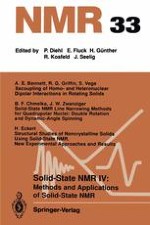1994 | OriginalPaper | Chapter
Solid-State NMR Line Narrowing Methods for Quadrupolar Nuclei: Double Rotation and Dynamic-Angle Spinning
Authors : B. F. Chmelka, J. W. Zwanziger
Published in: Solid-State NMR IV Methods and Applications of Solid-State NMR
Publisher: Springer Berlin Heidelberg
Included in: Professional Book Archive
Activate our intelligent search to find suitable subject content or patents.
Select sections of text to find matching patents with Artificial Intelligence. powered by
Select sections of text to find additional relevant content using AI-assisted search. powered by
Among the features of nuclear magnetic resonance (NMR) spectroscopy that have made it such a versatile and powerful collection of analytical methods is the freedom to manipulate independently both spin and spatial components of the nuclear spin interaction tensors. This imparts enormous flexibility and selectivity to the type of structural and dynamical information that can be obtained about a chemical system at a molecular level. Depending on the information desired, experiments can be designed to measure, remove, or correlate one or more of the principal spin interactions, including the chemical shift, spin-spin scalar (J) coupling, electric quadrupole coupling, and magnetic dipole-dipole coupling, each of which depends on molecular orientation. Often one of the chief aims of such intervention is to enhance spectral resolution, and thereby augment the information content of the NMR spectrum, through judicious control of time-dependent radiofrequency (B1) fields and/or manipulation of sample orientation with respect to a large static field (B0). In low-viscosity liquids, fast isotropic molecular motion averages all anisotropic interactions, so that narrow line widths are readily obtained for each distinguishable site in a molecular system. Narrow spectral lines in these systems reflect, for example, the isotropic value of each site-specific chemical shift tensor (modified potentially by an isotropic.J-coupling contribution as well), which is averaged over all possible orientations by rapid molecular motion on the NMR time scale. Such an isotropic sampling criterion is equivalent to averaging all nuclear spin interactions over a sphere, whereby only those contributions that are independent of molecular orientation remain, namely the isotropic terms.
